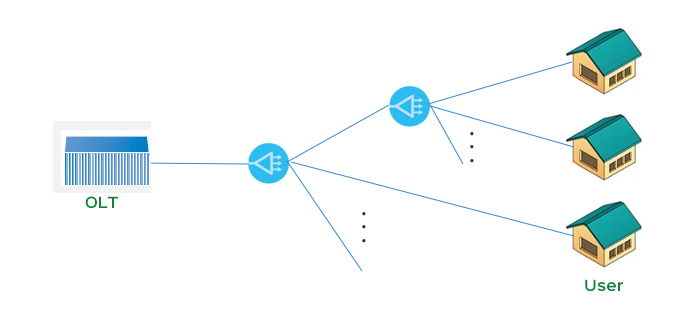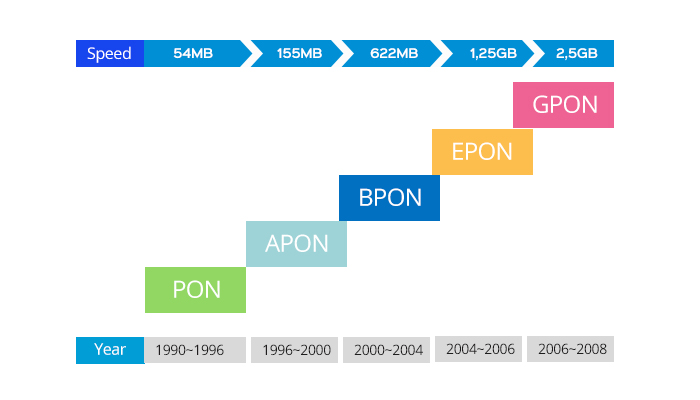PON(Passive Optical Network) means there is no any active equipment and only use Optical Fiber and Passive Components between OLT ( Optical Line Terminal) and the ONU ( Optical Network Unit). And PON in the main technology to implement FTTB/FTTH, which mainly adopts point to multi-point network structure.
There are a lot of content in PON Technology, and the PON Technology is constantly iterating and updating. XPON Technology developed from APON, BPON, and later EPON and GPON. There are different transmission modes and transmission standards developed at different times.
What is APON?
At the end of 1990s, ITU ( International Telecommunication Union ) First proposed APON using Asynchronous Transfer Mode ( ATM) for packet Communication. APON makes use of the centralized and statistical multiplexing of ATM, combined with the sharing function of passive divider on optical fiber and Optical Line Terminal, which makes the cost lower by 20%~40% than the traditional PDH/SDH access system based on circuit switching.
What is BPON?
With the rapid development of Ethernet Technology, APON is basically no longer used. At this time, the concept of Broadband Passive Optical Network ( BPON) was proposed. BPON is an enhancement of the APON standard, originally known as APON, but later changed to BPON for different purposed. BPON is based on ATM protocol, with upstream and downstream speeds of 155Mbpas and 622Mbps respectively. At the same time, It adds dynamic bandwidth allocation,protection and other functions, and can provide Ethernet access, video transmission, high-speed leased Lines and other services.
What is EPON ?
Due to the high deployment cost of BPON, it was subsequently replaced by the more cost-effective and faster EPON.EPON (Ethernet Passive Optical Network) is an Ethernet Passive Optical Network.EPON PON technology based on Ethernet integrates the advantages of PON technology and Ethernet technology, adopts Point to Multi-point structure, passive optical fiber transmission,
Due to the high deployment cost of BPON, it was subsequently replaced by the more cost-effective and faster EPON.EPON (Ethernet Passive Optical Network) is an Ethernet Passive Optical Network.EPON PON technology based on Ethernet integrates the advantages of PON technology and Ethernet technology, adopts Point to- Multi-point structure, passive optical fiber transmission,and provides a variety of services on Ethernet.Because EPON is economical and efficient to deploy, it is the most effective way to achieve “three networks in one” and “last mile” communications.
What is GPON?
GPON (Gigabit-Capable Passive Optical Network) is a Gigabit Passive Optical Network or Gigabit Passive Optical Network.EPON and GPON use different standards, and GPON is arguably more advanced, able to transmit more bandwidth and carry more users than EPON.Although GPON has advantages in high speed and multiple services compared with EPON, GPON’s technology is more complex and its cost is higher than that of EPON.Therefore, at present, EPON and GPON are the most widely used technologies for PON broadband access, and the choice of which technology depends more on the cost of optical fiber access and business requirements.GPON will be better suited to customers with high bandwidth, multi-service, QoS and security requirements, and ATM technology as the backbone.The future development is higher bandwidth, for example, EPON/GPON technology develops 10 G EPON / 10 G GPON, the bandwidth will be further improved.
Knowing more about APON,BPON,EPON,GPON
As the capacity demands on network providers continue to increase, the versatility of access networks must also expand to meet this growing demand.Fiber to the home (FTTH) passive optical network (PON) optical network access is the most widely used and implemented technology.The advantages of PON technology are that it can reduce the utilization of backbone fiber resources and save investment.Flexible network structure, strong ability to expand;Passive optical devices have low failure rate and are not easy to be interfered by external environment.Strong business support ability, etc.







